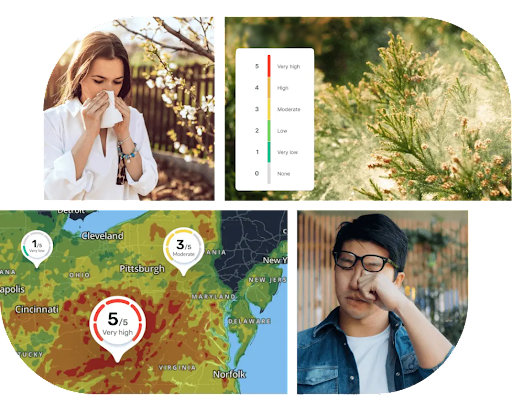
Mit der Pollen API können Sie Pollendaten für einen bestimmten Standort anfordern. Die Pollendaten umfassen regionale Pflanzen- und Pollenarten sowie den Pollenindex und Gesundheitsempfehlungen.1 Die Pollen API deckt über 65 Länder mit einer Auflösung von 1 × 1 km ab.
Die API bietet Endpunkte, mit denen Sie Folgendes abfragen können:
Vorhersage:Bis zu 5‑Tage-Pollenflugvorhersage mit täglichen Informationen, einschließlich Pollenindex für Pflanzenarten.2
Heatmaps:Farbcodierte Kacheln für drei Pollenarten.
Funktionen der Pollen API
Tägliche Vorhersage des Pollenindex und der Kategorien:Die Pollen API berechnet kontinuierlich den Wert verschiedener Pollenarten und Pflanzenindizes mit einer Auflösung von 1 × 1 km.
Gesundheitsempfehlungen:Empfohlene Gesundheitsinformationen basierend auf den aktuellen Pollenwerten. Gesundheitsempfehlungen werden auf der Ebene des Pflanzentyps entsprechend dem Pollenindex umgesetzt.[^1]
Details zur Pflanzenbeschreibung:Detaillierte Informationen zu den verschiedenen Arten, die sich auf die Pflanze und ihr allergenes Potenzial beziehen. Die Beschreibung enthält die folgenden Informationen: Typ, Familie, Saison, besondere Formen, besondere Farben, Kreuzreaktion und zwei Bilder jeder Pflanze.
Heatmaps:Eine Sammlung von Bildkacheln mit Pollenindex, die über Google Maps angezeigt werden können.
Abdeckung der Pollen API nach Land und Region
Hier finden Sie die aktuellen Abdeckungsdetails für die einzelnen Länder, aus denen Pollen- und Pflanzeninformationen verfügbar sind.
Verwendung der Pollen API
| 1 | Einrichten | Beginnen Sie mit Google Cloud-Projekt einrichten und folgen Sie der Anleitung. |
| 2 | Tägliche Pollenflugvorhersage abrufen | Weitere Informationen finden Sie unter Prognose abrufen. |
| 3 | Heatmap-Kacheln abrufen | Weitere Informationen finden Sie unter Heatmap-Kacheln abrufen. |
Nächste Schritte
-
Die Anzahl der vorhergesagten Tage kann je nach Standort und Pflanzenart variieren. ↩

